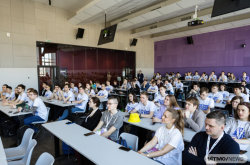Sberbank Technologies emerged as result of Sberbank transforming from a classical financial structure in an IT company. Everyone remembers the sad story of such late industry leaders as Kodak, Nokia, Polaroid - those that failed to change in the conditions of a constantly developing world. If a company doesn’t change its business model, it eventually fails, believes Danil Kabanov. This is why Sberbank places such emphasis on new technologies. The new company’s main objective is to provide technological solutions for the whole Sberbank group. Also, the very idea of Sberbank gradually changes as Sberbank becomes an ecosystem; new services that don't have anything to do with banking emerge as its part, like Sberbank Telecom (a network provider) or DocDoc (digital medical service).
As of today, Sberbank is set on launching several research laboratories focusing on eight fields, each responsible for a particular trend (IoT, machine learning, blockchain, robotization, quantum computations and other technologies). Sberbank Technologies plays an active role in this endeavor. For instance, its St. Petersburg’s office focuses on blockchain technologies and the Internet of Things. One of Sberbank’s objectives here is to create a domestic service provider for high-tech devices, i.e. unite such devices in a common platform, gather and process relevant data and thus offer services that would be beneficial to both the bank and its clients.

The speakers explain that blockchain is a great option for when one needs an agent between two participants so as to enhance the level of credibility. As for today, accountants carry out the reconciliation checks by sending each other excel documents; for every change made, the documents are to be sent anew, so the process can take lots of time. When using blockchain, the smart contract code (an electronic algorithm used for the automation of processes in blockchain) is open to all of the communication’s participants, so that they can see that there are no violations. Also, the information is encoded stepwise, which allows to create some digital imitation of time-flow. If one piece of information is deleted from the middle of a chain, the chain deteriorates and becomes invalid. This is why blockchain works great for tracing business processes: once you sign a contract, it is forever included into the company’s history.
Yet, there are also some hidden dangers that have to do with blockchain. As of now, the technology is yet to be legislated; this means that from the legal point of view, a smart contract has no force. This is why all notable cases that made use of blockchain technologies were still secured with traditional official documentation, the new technology is being used to provide for honest information transfer only. If the parties are set on playing fair, blockchain offers a great system for information exchange that makes the process transparent.

Today, there are different platforms that offer such instruments (for instance, Sberbank often uses Ethereum, Hyperledger Fabric and Exonum). The first blockchain platforms appeared some three-four years ago and were quite primitive, so a lot had to be done manually - for instance, writing the line concatenation functions and the like. Today, modern platforms offer a lot more opportunities, as well as better transaction speed. Almost every month, new platforms appear on the market, each better than the previous ones. Monitoring the development of new platforms and choosing those best suited for particular cases are amongst the responsibilities of those working for Sberbank Technologies.
One of the recent projects that made use of blockchain had to do with insurance. Today, insurance companies don’t have to report on how they spend the money they receive from their clients. With the introduction of blockchain, all operations become transparent, which increases the system’s credibility.
One has to understand that an insurance company does not exactly own money, but manages these funds. It takes the commission of several percent of the overall amount of money, but the remaining funds are to be spent on insurance payments. Using blockchain can also add the personalisation function to the case. This means that a client can get a report showing how exactly his payments were used. This way, insurance payments cease to be impersonalized processes - now, one can learn the names of those who contributed to helping a particular person. Still, one has to understand that whether to reveal their identity is the choice that clients make, so they can prioritize their privacy and remain anonymous.

Among the other notable presentations were the one by professor Peter Sloot from the University of Amsterdam who spoke about early-warning signals of the recent credit crisis, the presentation by Alexey Yakovlev from the Almazov National Medical Research Center who expanded on informatization as the global trend in modern Healthcare, and the presentation by Sergey Kovalchuk from ITMO’s High-Performance Computing Department who focused on predictive modeling in medicine and healthcare. Klavdiia Bochenina, another associate professor from the High-Performance Computing Department and one of the key participants of Russian Science Foundation’s project, also made a presentation on high performance simulation of dynamic processes in social networks, namely the objectives, methods and algorithms of effective parallel modeling of dynamic processes on large complex networks.





